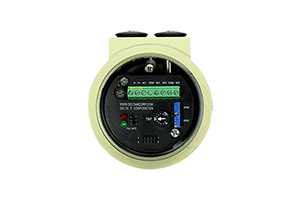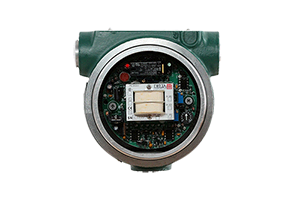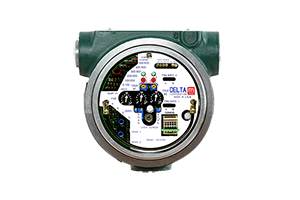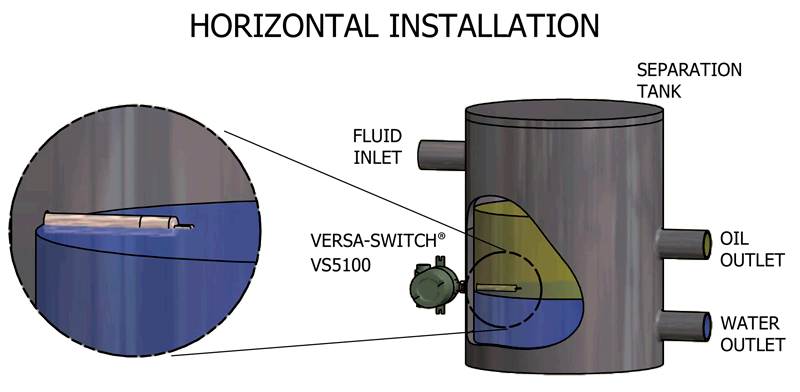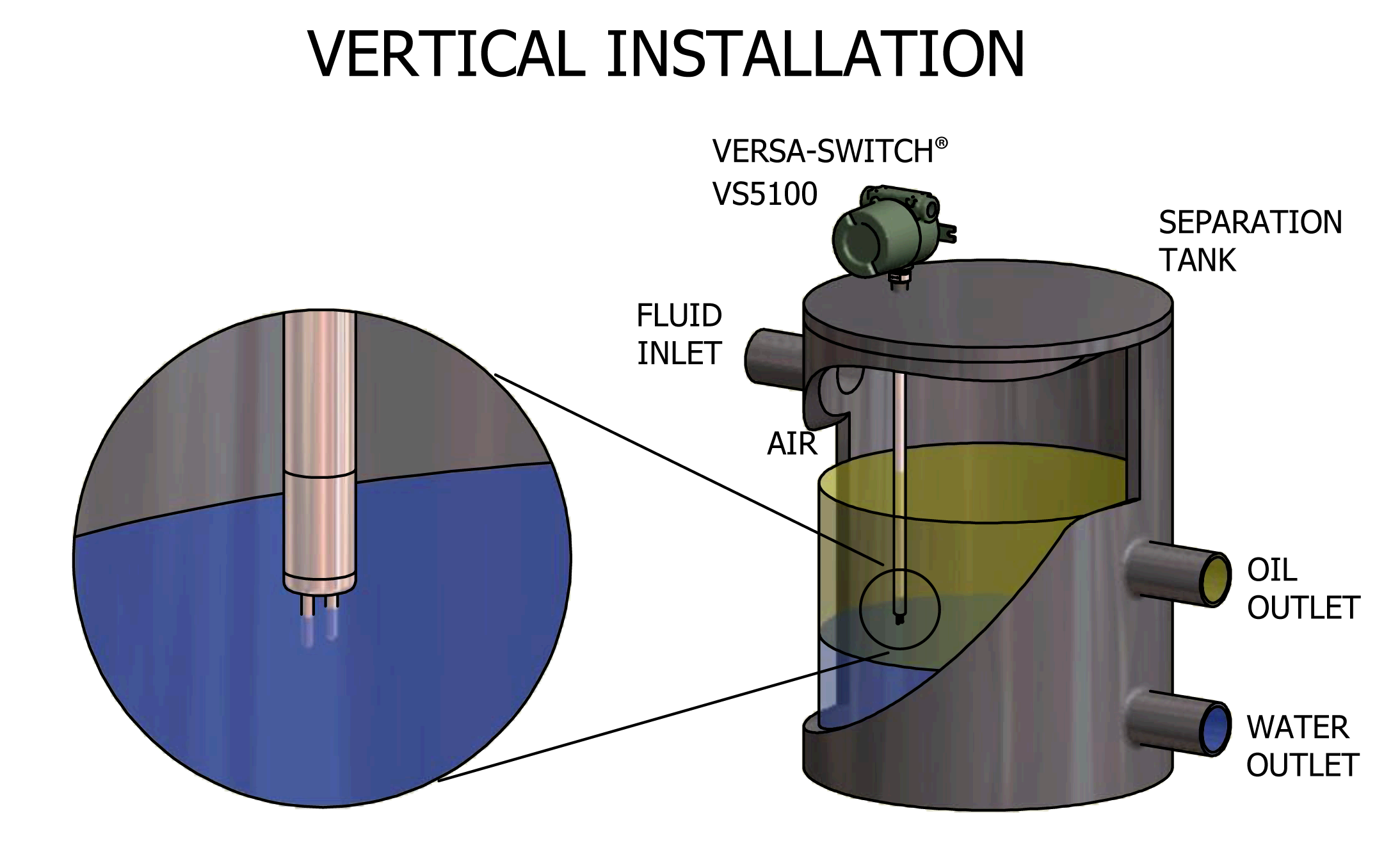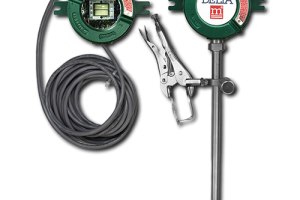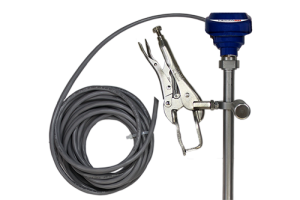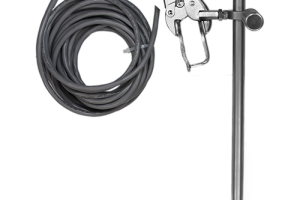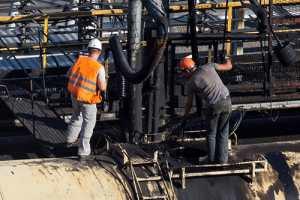Dual Channel Liquid Level
+ Agitation Indicator
Applications:
Tank Liquid Level Monitor
Tank Liquid Agitation Indicator
Full Tank Liquid Level Indicator
Liquid Level Switch
Application Background:
It is often desirable to monitor the level of a liquid in a process tank or vessel. In addition to the level of the fluid, a dual channel sensing switch can also be configured to indicate when agitation is taking place in the tank (i.e. stirring action).
Application Solution:
A level switch with dual channels has the capability of setting two discrete liquid level interaction set points. Normally the first channel would be set for a high level condition but with a time delay. The first channel would trip a relay only when the sensing probe was fully covered with the liquid product for an extended time period whether or not agitation was taking place. The second channel is then calibrated to trip a second relay when the agitation (stirring) is taking place as the sensing probe is being covered and uncovered by the liquid product.
 For full calibration details see Section 4.4.7 of the VS5100 Series manual
For full calibration details see Section 4.4.7 of the VS5100 Series manual
[levelproducts]
Interface Level Detection Switch
Applications:
Oil/Water Interface
Gasoline/Water Interface
Three Phase-Air/Hydrocarbon/Water Interface
Application Background:
Separation Tanks are in common use in industrial situations where mixed water/hydrocarbon fluids are produced by a process. Pumping oil from the ground and pumping gas from the ground using “fracking” fluids both produced mixtures of hydrocarbon and water that must be separated.
Separation Tanks allow the water to settle to the bottom of the tank while the oil or other hydrocarbon product surface to the top. The valuable hydrocarbon product is drained through a valve located on the tank above the water level. The dump water is drained through a valve below the water level. This is a continuous, ongoing process.
The key is to monitor the interface between the hydrocarbon and water to ensure that the separation is well defined and mixtures are not allowed to be discharged through the wrong discharge valves.
Application Solutions:
There are many interface switch technologies including: manual sticking, manual sampling, sight glass, conductivity and capacitance probes, floats and others. Most can work with varying degrees of success. Some rely on operator’s attention and memory. Some have mechanical parts and prone to wear and failure. Still other electronic type probes require conducting fluids or fluids with different capacitance.
A better solution for the interface detection is the Thermal Differential Switch. The TD Switch has two thermal sensing devices (RTD’s) encased in stainless steel tips. One sensor detects the temperature of the fluid while the second has a very small current applied to create a thermal differential above the fluid temperature. The differential temperature between water and a hydrocarbon is different. Therefore detection of the interface is achieved reliably, with excellent repeatability.
With a single process connection into the separation tank either through the side (horizontally) or through the top (vertically) a TD probe is strategically located to optimize the interface point between the two fluids (ex. Oil and water). With the dual channel VersaSwitch product from Delta M Corporation it is easy calibrate one switch channel for the hydrocarbon and the second switch channel for water. Separate relays activate depending upon with the sensor probe is covered by water or by the hydrocarbon.

 *Three Phase Detection is only capable
*Three Phase Detection is only capable
with the VS5100 model*
For full details see Section 4.4.4 of the VS5100 manual
for Three Phase (Dual Interface) Calibration
[levelproducts]
A shielded VERSA-SWITCH® VS5100 probe is installed in the tank with Channel 1 set to detect foam; Channel 2 is set to detect liquid. When foam reaches the switch, the switch turns on a pump that feeds liquid to nozzles in top of the tank and the spray knocks the foam down (shield keeps spray from tripping Channel 2). When the liquid reaches the switch it shuts down the feed pump and the foam knockdown pump. This allows greater storage capacity in tank and prevents product overflow or wastage, thus reducing the burden on the plants waste treatment facility.
Truck and Railcar Loading
Applications:
TANK, TANKER TRUCK LOADING
RAILCAR LOADING
TANK, TANKER OVERFILL MONITOR | PROTECTION
TANK, TANKER TRUCK OVERFILL MONITOR | PREVENTION
TANK, TANKER RAIL CAR OVERFILL MONITOR | PREVENTION
CLAMP-ON LEVEL SWITCH
Application Background:
Overfilling or overflowing a liquid product in a tanker truck or tanker rail car can create a safety and environmental hazard, not to mention the loss of valuable product, and can be very expensive. Having a way to know when the level of the liquid product is getting close to the top of the tank or vessel would provide a warning to take preventative measures against an overflow.
Application Solution:
There are many liquid level monitoring technologies including: manual sticking, site glass, floats, conductivity probes, capacitance probes, vibrating forks, etc. All have proven to work with varying degrees of success. Some rely on operator’s time and attention, while some have mechanical parts and are prone to wear, hang-up, and failure. Still other electronic type probes require conductive fluids or fluids of different capacitance or viscosities.
A better solution for liquid level detection at a specific point in the tanker trucks and rail cars is the Thermal Differential Switch. The TD switch has two thermal sensing devices (RTD’s) encased in ruggedized stainless steel tips. One sensor detects the temperature of the liquid while the second has a very small current applied to create a thermal differential above the liquid temperature. The differential temperature between air and liquid is different. Therefore detection of an uncovered sensor probe and a probe covered by the liquid is a simple, reliable technique for a point level monitor.
With a simple clamp-on connection to the manway opening in the tanker a TD probe can be strategically located to monitor for approaching high liquid level alarm point. When the probe detects the liquid, the TD switch activates a relay output to alarm and/or activate a control step to stop the impending overflow.
Any of the Delta M Corporation microtuf® and Versa-Switch® liquid level product models can provide the solution in this application. The dual channel Versa-Switch® has the added feature of a second relay contact for a Failure Alarm (FA) option to watchdog the unit for power failure or interrupt, sensor failure, electronics failure, etc. This combination provides for the best security and assurance that the point level switch is ready at all times to provide for the overfill protection.

TLP - Truck Loading Probe / Tank Loading Probe - EX Rated Option

TLP - Truck Loading Probe / Tank Loading Probe - Weather Head Option

TLP - Truck Loading Probe / Tank Loading Probe - Weather Head Option

Tank Loading Application

Tank Loading Application
For full calibration details see Section 4.4.1 of the VS5100 Series manual
[levelproducts]
When tanks are installed underground it is quite often required that these tanks have 2 walls with an air space between the walls. It is important to know that these tanks are in good condition and not leaking. With the switches configured to detect interface you can be notified of the source of any leak. If the outer tank wall is leaking we would detect ground water entering the air space. If the inner wall is compromised then we would detect the contents of the tank leaking into the air space.
In many manufacturing facilities, sumps can be a big problem. Seldom do you know what is going to end up in the sump; it can be anything from acid to tar. In a situation like this, the DELTA M thermal differential level switch is ideal since it has no moving parts to stick and is available in many exotic materials that are compatible with most chemicals. The DELTA M multi-point level switch is ideal for these applications. The switches can have from 2 points to 6 points with 3 or 4 being very common. In power plants, for example, you may want additional points for booster or back-up points.
Liquid Multi Point Level
DELTA M has many customers that use our switches to determine if water is present in fuel storage tanks. Several large northern city rapid transit authorities use DELTA M switches to continuously remove water from fuel storage tanks. Two switches are mounted close to the bottom of the tank with one being slightly higher than the other. As water separates from the fuel, it settles to the bottom. When the DELTA M switch mounted higher in the tank detects water, it activates a pump which pulls the water from the bottom of the tank. When fuel reaches the switch mounted closest to the bottom of the tank, the switch senses the presence of the fuel and shuts off the pump. This allows for very inexpensive automatic control.
While a vessel or reactor is being charged, you can compare DELTA M switch point indications to any continuous unit’s output. The DELTA M switch indicating points can’t change once installed making them very reliable as backups to other forms of level measurement. Example: When charging a critical reactor, the operator or, in many cases, the control system compares our switch point indications to the output from the continuous level instrument. If they agree, charge continues. If not, the reaction is aborted and a possibly serious accident is prevented.





